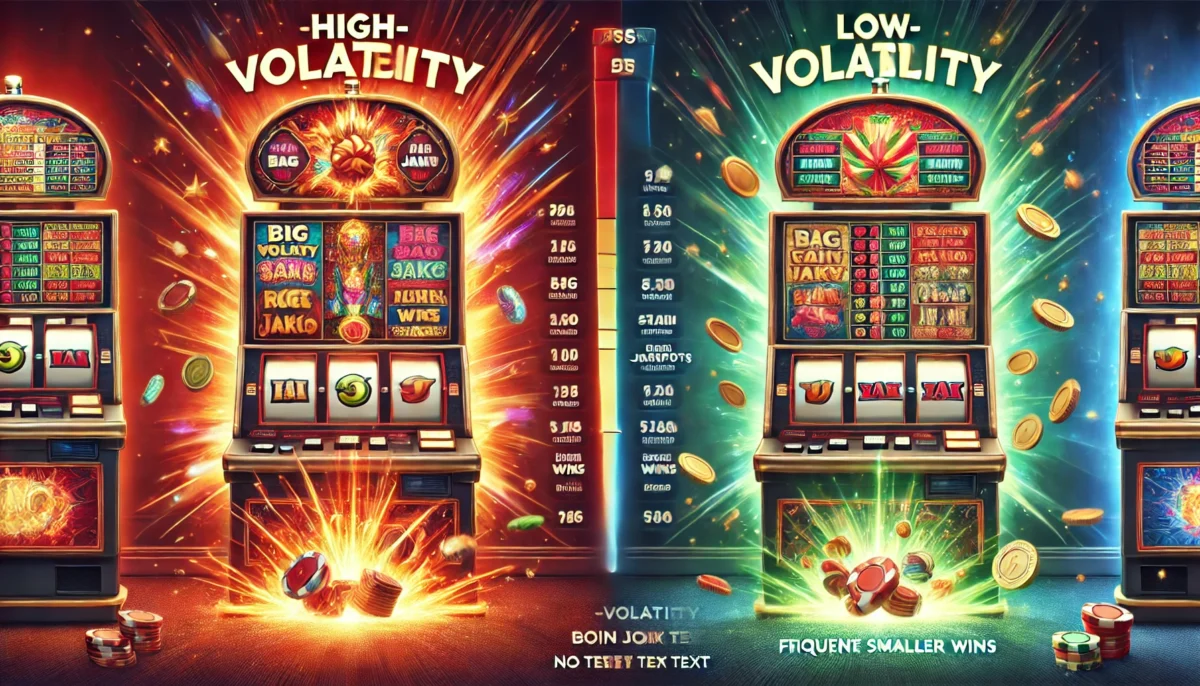Introduction
Slot machines are among the most popular games in both land-based and online casinos, offering a wide variety of themes, features, and payout potentials. One of the most important factors to consider when choosing a slot game is its volatility—a key element that determines how often and how much a game pays out. Understanding the difference between high-volatility and low-volatility slot machines can help you select games that align with your budget, risk tolerance, and playing style. In this guide, we’ll explore how these two types of slots differ and how to choose the best one for you.
1. What Is Slot Volatility?
Volatility, also known as variance, refers to the risk level of a slot game and how often it pays out.
- High-Volatility Slots: Offer large but infrequent payouts.
- Low-Volatility Slots: Offer smaller but more frequent payouts.
Understanding this concept is crucial for making smarter gameplay decisions and managing your bankroll effectively.
2. Understanding High-Volatility Slot Machines
Key Features:
- Infrequent Wins: Wins occur less often but tend to be larger.
- Higher Risk: These games can quickly drain your bankroll if you’re not lucky.
- Big Jackpots: Often feature progressive jackpots and high-paying bonus rounds.
- Longer Play Sessions Required: May take longer to trigger significant wins.
Pros:
- Massive Win Potential: Ideal for players chasing life-changing payouts.
- Exciting Gameplay: The anticipation of a big win adds to the thrill.
- Engaging Bonus Features: Often packed with interactive bonuses and free spins.
Cons:
- Extended Dry Spells: Can go long periods without wins.
- Requires Larger Bankroll: You need enough funds to sustain losing streaks.
- Not Ideal for Casual Players: May not suit players looking for frequent wins.
Best For:
- Risk-takers and thrill-seekers.
- Players with a larger bankroll.
- Those who enjoy chasing big jackpots.
Examples of High-Volatility Slots:
- Dead or Alive II (NetEnt)
- Bonanza Megaways (Big Time Gaming)
- Book of Dead (Play’n GO)
3. Understanding Low-Volatility Slot Machines
Key Features:
- Frequent Wins: Offers consistent, smaller payouts.
- Lower Risk: Ideal for longer gameplay sessions without big losses.
- Modest Jackpots: Payouts are smaller but more predictable.
- Simple Gameplay: Often more straightforward with fewer complex features.
Pros:
- Steady Payouts: Keeps players engaged with frequent wins.
- Budget-Friendly: Great for casual players and beginners.
- Longer Play Sessions: Bankroll lasts longer due to regular wins.
Cons:
- Smaller Wins: Less opportunity for massive payouts.
- Less Excitement: Can feel repetitive without high-risk features.
- Limited High-Payout Bonuses: Fewer big bonus features compared to high-volatility slots.
Best For:
- Beginners and casual players.
- Players with smaller bankrolls.
- Those looking for relaxed, extended play sessions.
Examples of Low-Volatility Slots:
- Starburst (NetEnt)
- Blood Suckers (NetEnt)
- Thunderstruck II (Microgaming)
4. Comparing High-Volatility and Low-Volatility Slots
| Feature | High-Volatility Slots | Low-Volatility Slots |
|---|---|---|
| Win Frequency | Infrequent but large wins | Frequent but smaller wins |
| Risk Level | High risk, high reward | Low risk, steady rewards |
| Required Bankroll | Larger bankroll needed | Suitable for small or moderate bankrolls |
| Game Pace | Slower, with long dry spells | Faster-paced with consistent payouts |
| Player Type | Thrill-seekers and risk-takers | Casual and budget-conscious players |
| Max Win Potential | Extremely high (jackpots) | Lower but consistent payouts |
| Example Games | Dead or Alive II, Bonanza Megaways | Starburst, Blood Suckers |
5. How to Choose the Right Slot for You
1. Assess Your Risk Tolerance
- High Risk, High Reward: Choose high-volatility slots if you’re comfortable with losing streaks for the chance at massive wins.
- Low Risk, Steady Wins: Opt for low-volatility slots if you prefer frequent, smaller payouts.
2. Consider Your Bankroll
- Large Bankroll: If you can afford larger bets and longer losing streaks, high-volatility games could be rewarding.
- Small to Medium Bankroll: Low-volatility slots allow for longer, more sustainable play.
3. Define Your Gaming Goals
- Big Jackpots: If your goal is to win big, high-volatility games are your best bet.
- Entertainment and Fun: If you’re playing for fun and relaxation, low-volatility games provide consistent excitement.
4. Time Commitment
- Long Sessions: If you plan to play for an extended period, low-volatility slots can make your bankroll last longer.
- Quick Thrill: High-volatility slots may be more exciting for shorter, high-stakes sessions.
6. Blending Both for the Best Experience
For many players, mixing high and low-volatility slots can create a balanced and enjoyable gaming experience.
- Start with Low-Volatility Slots: Build your bankroll with frequent, smaller wins.
- Switch to High-Volatility Slots: Use a portion of your winnings to chase bigger payouts.
- Set Limits: Establish win and loss limits to avoid overspending.
Pro Tip: Platforms like Dewakoin offer a wide selection of both high and low-volatility slots, allowing you to easily switch between game types.
Conclusion
Choosing between high-volatility and low-volatility slots depends on your personal preferences, bankroll size, and risk tolerance. High-volatility slots offer the thrill of big wins but require patience and a larger bankroll, while low-volatility slots provide steady, smaller wins for longer, more relaxed gameplay.
Platforms like Dewakoin make it easy to explore both types of slots, ensuring that every player can find a game that matches their style. Whether you’re chasing a life-changing jackpot or just enjoying some casual spins, understanding volatility will help you make smarter, more enjoyable gaming choices.
Ready to spin? Find your perfect game and start playing today!
